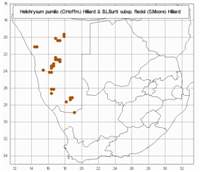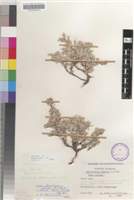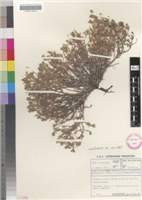Origin of name:
pumilio = dwarf, pygmy, close growing, shortfleckii = after E. Fleck geologists who worked in Namibia during 1888-1891.
Diagnostic characters:
Compact herbsSolitary headsBracts red-pink in lower half, opaque pink to white in upper half
Description:
Closely branched rounded dwarf shrublet c. 20-200 mm high or sometimes lax and open, taproot thick, woody, main stem gnarled, short, eventually up to 20 mm diam., branches erect or spreading, grey-woolly, densely leafy or sometimes more distantly so. Leaves mostly 4-20 x 1-4 mm, linear-spathulate, apex subacute, apiculate, base narrowed, petiole-like, very shortly decurrent, margins subrevolute, both surfaces generally thinly grey-woolly. Heads heterogamous, campanulate, c. 5-7 mm, sessile, solitary and terminal, often overtopped by younger growth, or solitary on dwarf lateral branchlets, or leaf-opposed and crowded at branchlet tips, or in small terminal corymbose clusters. Involucral bracts in c. 5 series, graded, loosely imbricate, inner about equaling flowers, outermost webbed to surrounding leaves, all semipellucid, white and rose, crimson or almost scarlet, the rosy tinge sometimes rather pale, very acute to acuminate or rarely more abruptly contracted to an acute tip, somewhat squarrose. Receptacle nearly smooth. Flowers 30-96, 6-30 (-51) female, 25-84 homogamous, yellow, sometimes tipped pink. Achenes 0.75 mm, with myxogenic duplex hairs. Pappus bristles many, equaling corolla, scabridulous, bases cohering lightly by patent cilia.
Flowers mainly between July and December.
Distribution:
Grows in rocky or gravelly places, often in clefts in rocks, mainly on mica schist, quartz and granite. Subsp. fleckii has been recorded only in the highlands of Namibia, from the Waterberg and Brandberg, the mountains about Windhoek, the Khomas Hochland, the Gamsberg and Naukluft mountains, south to the heights near Aus and the Little and Great Karasberge.
Nama Karoo and Desert Biomes.
Notes:
Can be confused with H. cerastioides, particularly var. aurosicum.
Two subspecies are recognized:
(a) subsp. pumilio (b) subsp. fleckii
Differs from the typical plant principally by its white and rose, crimson or almost scarlet involucral bracts, the rosy tinge sometimes rather pale. In the southernmost part of the range, some specimens are not or scarcely to be distinguished from typical H. pumilio. Heads range from c. 5-7 mm long; leaves are generally thinly grey-woolly, but there appear to be either local races or sporadic occurrences of plants distinguished by absence of wool (H. viscidissimum) or by the possession of very densely woolly leaves (H. dinteri), or older leaves can be green and glandular, young leaves grey-woolly on the same plant; phenomena all paralleled in several other species of Helichrysum.
Taxonomy:
Literature:
Helichrysum pumilio (O. Hoffm.) Hilliard & Burtt subsp. fleckii (S. Moore) Hilliard
Type:
Namibia, Great Namaqualand, Nauchas [?], April 1891, Fleck s.n. (Z, holo.; BM, iso.).
Synonym(s):
H. fleckii S. Moore in Bull. Herbarium Boissier s�r. 2, 4: 1017 (1904); Moeser in Bot. Jb. 44: 303 (1910); Merxm., F.S.W.A. 139: 93 (1967).
H. dinteri S. Moore in Bull. Herbarium Boissier s�r 2, 4: 1016 (1904). H. fleckii var. dinteri (S. Moore) Merxm. & Schreiber in Mitt. bot. StSamml. M�nch. 2: 329 (1957); Merxm., F.S.W.A. 139: 934 (1967). Type: Hereroland, Waterberg plateau, Dinter 387 (Z, holo.; BM, iso.).
H. viscidissimum Hutch, in Ann. Bolus Herbarium 3: 7 (1920); Merxm., F.S.W.A. 139: 98 (1967). Type: Namibia, Naukluft Mts below Goas, Pearson 9066 (K, holo.; BOL; SAM, iso.).
H. viscidissimum Hutch, var. volkii Merxm. in Mitt, bot. StSamml. M�nch. 2: 331 (1957), F.S.W.A. 139: 99 (1967). Type: Namibia, Otjiwarongo distr., Little Waterberg, Volk 2332 (M, holo.).
Vouchers:
Dinter 853 (SAM); Merxm�ller & Giess 28262 (M; PRE; WIND); �rtendahl 515 (BOL; K; PRE); Merxm�ller & Giess 28143 (M; PRE), all typical H. fleckii; Meyer 1183 (M; WIND), typical H. dinteri; Strey 2165 (BOL; NBG; PRE), typical H. viscidissimum; Acocks 18037 (PRE), Kinges 2378 (M; PRE), pale heads, scarcely to be distinguished from subsp. pumilio.


